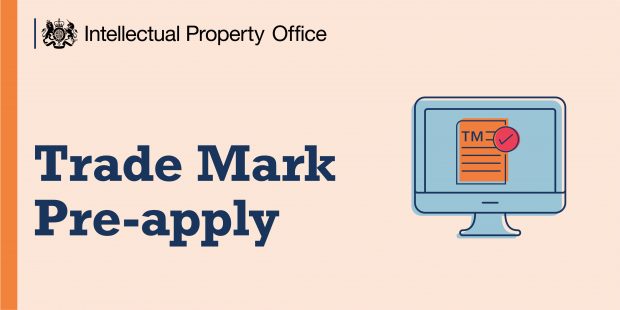What is trade mark pre-apply?
In April, we published a blog called ‘How can Artificial Intelligence (AI) Improve Customer Experience at IPO?’. It introduced a new online tool we are developing to help improve customers’ chances of successfully registering a trade mark, powered by artificial intelligence.
It allows customers to check:
- if anyone already has a trade mark too similar to the one they want
- their proposed trade mark against basic trade mark rules
- their estimated application costs
Today, we are delighted to announce that the trade mark pre-application tool has launched into public beta. This means that the service is available for anyone to use, but it is an early version that is still under development.
In this blog, we will explain the improvements we’ve made since April and what to expect in the future.

Our approach to improving the tool
Since April, a lot has changed in the world and the project! There have been three major areas of focus:
- testing the tool to understand what worked well and where to improve
- reducing the length of the customer journey
- making tasks easier to understand and complete
To understand what we needed to improve, we have tested the tool with a range of people including small and medium sized businesses, IP professionals and trade mark examiners. We’ve had feedback from people with a range of experience with trade marks, from experts to novices.
A quicker experience
It soon became clear that we needed to make it quicker and easier for people to get to their results. Originally we had the tool split into 3 phases, each of which had a results page. People found this confusing – they thought they had reached the final results page when they were only part of the way through the journey. In response, we reduced the number of steps people needed to go through from 14 to 7, halving the length of time it takes to reach the results page.

An easier experience
We spent a lot of time testing different ways of making things easier for people to understand. One way we did this was by simplifying the language so it was relatable, meaningful and jargon-free. For example, previously we asked people to choose the relevant ‘class’ for their trade mark. Our feedback showed ‘class’ was an unfamiliar term to a lot of customers and can unnecessarily complicate the selection process. We then changed it to ‘goods and services’, which is more meaningful and specific.
We also changed our philosophy on how we provided guidance to people. Instead of providing it at the start of the journey, we shifted to context relevant guidance that is provided when and where it is most needed. For example, we provided examples of what different types of trade mark look like (eg word only, an image or image with words). So, when people are asked to choose the type of trade mark they would like to register, they can clearly understand the different options.
Considering the whole journey
We’ve thought carefully about where the tool should fit in the wider experience of somebody applying for a trade mark. Where do people go when they want to apply for a trade mark? What content do they look at? Where will the tool be most helpful and relevant to them?
We decided to embed the tool inside the trade mark application form. We did this because:
- we know this is a route that anybody applying for a trade mark will take
- the form has a separate journey for novice customers that ensures we are targeting it at the right audience
- we are placing the tool where it is most relevant and impactful
What are the limitations?
We have also been careful to explain the limitations of the tool to ensure we are setting the right expectations. For example, we are clear that the results can give you an indication of what objections could be raised against a trade mark, but it can’t give you a final, definitive answer. Equally, the advice provided by the tool is no substitute for professional advice from a trade mark attorney. Ultimately, we still want decisions about registering trade marks to be made by IPO staff, given how complex and valuable they can be.
What’s next?
It’s really exciting to finally share the tool with our customers and see how it improves the ease and quality of trade mark applications. There is still more work to do though. We will continue to look at feedback and make improvements throughout the public beta. In the meantime, feel free to try it out and give us feedback on how well the new service works.
To access the tool, go to the first page of the trade mark application form on GOV.UK. Select the first option ‘trade mark owner or the authorised person within their business’ and click ‘continue’. You will then be presented with the option to access the pre-apply tool or continue with your trade mark application.
We will provide a further update on our progress as the service develops and improves during public beta.
For more information and to access the tool, read our news story.

4 comments
Comment by Martin Layton posted on
Hi, I am an IP Business Adviser, but not a professional Trade Mark Attorney. I used the new tool to run a quick cross check of a client mark that I gave informal advice on earlier in the week in relation to clothing and jewellery (and sale of) – including conducting a trade mark search. I thought that the tool was pretty helpful overall, although the classification guide did not recommend Class 35 (eventhough I put in “selling clothes” given in the guide note...), nor class 14 - eventhough I put in jewellery - which is more worrying… This suggests that the classification area of the tool may require review to ensure that alternate spelling of terms and key words are picked up where appropriate. The mark comparison search tool was pretty handy and picked up one mark that was of real relevance (and a multitude of others that were less so...). Overall I thought the tool may be helpful for the informed, but perhaps less so for members of the general public e.g. if they are new to trade marks and unable apply judgement on what is relevant - and what the tool may have missed... I appreciate that this is a work in progress however - and consider that it is a great initiative and definitely worth the IPO investing in further to refine. I look forward to using the tool in future - and further updates and refinements as they become available.
Comment by Simeon Bowen posted on
Thank you for the feedback Martin, we're glad you found the tooI useful. We expect the the results to get more accurate over time as the AI learns and improves the more it is used. We will also continue to develop the tool in response to feedback so it is as helpful as it can be for the general public. I have passed your feedback on to the project team so they can work on the specific points you've raised.
Simeon
Comment by Martin Layton posted on
Thank you Simeon, Appreciate you and the Team at the IPO taking this forward. I look forward to further developments.
Comment by Philip Charles Swift posted on
There is no such thing as AI. It is simply a buzzword for powerful servers and some human trying out an algorithm live on the human race. The sooner the human primate is eradicated from the Solar system, the better. Can I trademark 'Artificial Facts' please?